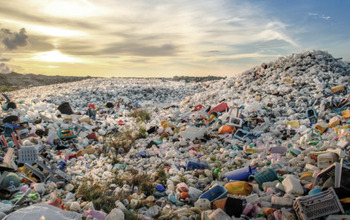Engineering the elimination of end-of-life plastic waste

New NSF projects seek ways to repurpose plastic waste and end its accumulation in the environment.
August 26, 2021
Plastic materials are ubiquitous to modern life, from healthcare to food production. However, the steep increase in plastic production over the past few decades has contributed to a massive global accumulation of unusable plastic waste. These end-of-life plastics build up in landfills, soil and water environments, as well as in animals and plants.
To propel the creation of scientific solutions for the capture, management and elimination of end-of-life plastics, the U.S. National Science Foundation (NSF) announces a new investment of $16 million in eight research awards.
“NSF’s investment will advance the creation of a circular plastics economy that makes manufacturing more sustainable and helps protect our health and environmental well-being,” said Susan Margulies, NSF assistant director for Engineering. “In the future, our manufacturing and recycling systems could be re-designed so that the plastic waste no longer contaminates our oceans and lands.”
Despite recent efforts, most plastic materials are too complex to be efficiently recycled with existing technologies. A single piece of plastic waste may contain a variety of polymers, additives, dyes, or even other materials such as metals and adhesives.
“For example, food wrappers, such as potato chip bags, are usually a combination of plastic film, metal foil and adhesive,” said NSF program director Christina Payne. “There are practically no cost- and energy-efficient solutions for recycling multilayer film packaging, meaning nearly all of it ends up in a landfill or lost to the environment.”
NSF-funded fundamental research will establish the knowledge, methods and tools needed to create new technologies capable of efficiently characterizing and separating plastics, breaking them down into environmentally benign or useful molecules, and repurposing them into new chemicals and materials that, ideally, will never reach a landfill.
“Valorization, or ‘upcycling,’ is the process of converting relatively low-value waste materials into high-value, high-quality polymers, chemicals, materials, energy sources and other products,” Payne said. “In the context of plastic waste materials, valorization methods take the molecular products of chemical or biochemical recycling processes and transform them into desirable goods.”
Breakthroughs in separation, recycling and valorization techniques have the potential to create a circular economy for plastics that could curb the production of virgin plastics and mitigate plastic waste accumulation across the globe.
The new interdisciplinary, fundamental research projects are supported by the NSF Directorate for Engineering’s Emerging Frontiers in Research and Innovation (EFRI) program along with the NSF Directorates for Biological Sciences and for Mathematical and Physical Sciences, in partnership with the U.S. Department of Energy's Bioenergy Technologies Office and the U.S. Department of Commerce’s National Institute of Standards and Technology (NIST).
The fiscal year (FY) 2021 investment in EFRI Engineering the Elimination of End-of-Life Plastics (E3P) will support eight new projects:
- High-throughput Synthetic Biology Approaches for Mixed Plastic Degradation and Reutilization, Texas A&M University
- Hydrogenolysis for Upcycling of Polyesters and Mixed Plastics, University of Colorado at Boulder
- Nonthermal Plasma-Assisted Hydrogenolysis of Waste Plastics to Value-added Chemicals and Fuels, University of Akron
- A Novel Sequential Catalytic Solvolysis Process for Deconstructing Municipal Waste Plastics, Washington State University
- Program Plastic Lifecycle by Rationally Designed Enzyme-containing Plastics, University of California, Berkeley
- Supercritical Extraction for the Elimination of End-of-Life Plastics, Auburn University
- Transformative Upcycling of Polymers by Activating Chemistries, University of Alabama
- Waste Management and Circularity of Crosslinked Polyurethane Foams, Arizona State University
The FY 2021 investment will build upon the $18 million FY 2020 investment in nine E3P projects.
Since 2007, the EFRI program has sought to inspire and enable researchers to work together across disciplines to expand the limits of engineering and to address pressing national needs and grand challenges.
“Investments in emerging frontiers and potentially-transformative, fundamental science and engineering research — such as engineering solutions to plastics pollution and cutting-edge chemical manufacturing — are indispensable for competing in the global innovation economy,” said Sohi Rastegar, head of the Office of Emerging Frontiers and Multidisciplinary Activities (EFMA), which oversees the EFRI program for the NSF Engineering Directorate.
-NSF-
Media Contacts
Media Affairs, NSF, (703) 292-7090, media@nsf.gov
Websites
NSF Emerging Frontiers in Research and Innovation program: https://www.nsf.gov/eng/efma/efri.jsp
The U.S. National Science Foundation propels the nation forward by advancing fundamental research in all fields of science and engineering. NSF supports research and people by providing facilities, instruments and funding to support their ingenuity and sustain the U.S. as a global leader in research and innovation. With a fiscal year 2023 budget of $9.5 billion, NSF funds reach all 50 states through grants to nearly 2,000 colleges, universities and institutions. Each year, NSF receives more than 40,000 competitive proposals and makes about 11,000 new awards. Those awards include support for cooperative research with industry, Arctic and Antarctic research and operations, and U.S. participation in international scientific efforts.
Connect with us online
NSF website: nsf.gov
NSF News: nsf.gov/news
For News Media: nsf.gov/news/newsroom
Statistics: nsf.gov/statistics/
Awards database: nsf.gov/awardsearch/
Follow us on social
Twitter: twitter.com/NSF
Facebook: facebook.com/US.NSF
Instagram: instagram.com/nsfgov


